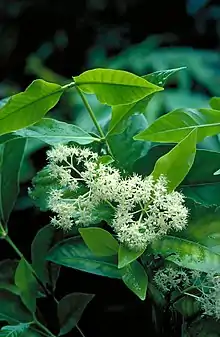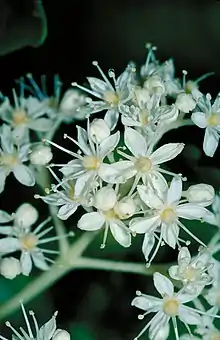| Northern towra | |
|---|---|
 | |
| Scientific classification | |
| Kingdom: | Plantae |
| Clade: | Tracheophytes |
| Clade: | Angiosperms |
| Clade: | Eudicots |
| Clade: | Rosids |
| Order: | Sapindales |
| Family: | Rutaceae |
| Genus: | Bosistoa |
| Species: | B. medicinalis |
| Binomial name | |
| Bosistoa medicinalis | |
| Synonyms[1] | |
| |

Bosistoa medicinalis, commonly known as the northern towra[2] or Eumundi bosistoa,[3] is a species of small to medium-sized rainforest tree that is endemic to Queensland. It has simple and pinnate leaves with two or three leaflets and panicles of small white flowers.
Description
Bosistoa medicinalis is a tree that typically grows to a height of bout 20 m (66 ft) high and has hard bark. The leaves are arranged in opposite pairs and are usually trifoliate, 70–180 mm (2.8–7.1 in) long on a petiole 10–15 mm (0.39–0.59 in) long. The leaves are sometimes simple or have two leaflets, but there are usually three egg-shaped leaflets, each 35–140 mm (1.4–5.5 in) long and 10–55 mm (0.39–2.17 in) wide, the end leaflet on a petiolule 3–17 mm (0.12–0.67 in) long. Simple leaves are 50–190 mm (2.0–7.5 in) long. The leaflets have prominent oil glands and a pointed tip. Each twig ends with two simple leaves and a terminal bud. The flowers are borne in panicles 50–100 mm (2.0–3.9 in) long, the sepals 0.5–1 mm (0.020–0.039 in) long and joined at the base, the petals 3–4.5 mm (0.12–0.18 in) long. Flowering occurs from February to October and the fruit is an oval to spherical follicle 9–12 mm (0.35–0.47 in) long, maturing from October to March. The seeds are oval to kidney-shaped, about 8 mm (0.31 in) long.[3][4][5]
Taxonomy
Northern towra was first formally described in 1866 by Ferdinand von Mueller who gave it the name Pagetia medicinalis and published the description in Fragmenta phytographiae Australiae.[6][7] In 1977, Thomas Gordon Hartley changed the name to Bosistoa medicinalis in the Journal of the Arnold Arboretum.[4][8]
Distribution and habitat
Bosistoa medicinalis grows in rainforest, often dry rainforest in near-coastal areas between the Pascoe River in northern Queensland to Woombye in south-eastern Queensland.[3][5]
Conservation status
This species is listed as of "least concern" under the Queensland Government Nature Conservation Act 1992.[2]
References
- 1 2 "Bosistoa medicinalis". Australian Plant Census. Retrieved 30 June 2020.
- 1 2 "Species profile - Bosistoa brassii". Queensland Government Department of Environment and Science. Retrieved 30 June 2020.
- 1 2 3 Hartley, Thomas G. (2013). Wilson, Annette J.G. (ed.). Flora of Australia (Volume 26). Canberra: Australian Biological Resources Study. pp. 51–52. Retrieved 30 June 2020.
- 1 2 Hartley, Thomas G. (1977). "A Revision of the Genus Bosistoa (Rutaceae)". Journal of the Arnold Arboretum. 58: 431–433. Retrieved 30 June 2020.
- 1 2 F.A.Zich; B.P.M.Hyland; T.Whiffen; R.A.Kerrigan (2020). "Bosistoa medicinalis". Australian Tropical Rainforest Plants Edition 8 (RFK8). Centre for Australian National Biodiversity Research (CANBR), Australian Government. Retrieved 2 July 2021.
- ↑ "Pagetia medicinalis". APNI. Retrieved 30 June 2020.
- ↑ von Mueller, Ferdinand (1866). Fragmenta phytographiae Australiae (Volume 5). Melbourne: Victorian Government Printer. pp. 178–179. Retrieved 30 June 2020.
- ↑ "Bosistoa medicinalis". APNI. Retrieved 30 June 2020.